Air Compressor Market Report
RA00040
Air Compressor Market, By Product (Portable, Stationary), By Technology (Rotary, Reciprocating, Centrifugal), By Lubrication (Oil Free, Oil Filled) By Application (Home Appliances, Food & Beverage, Oil & Gas, Manufacturing, Healthcare) and Regional Analysis (North America, Europe, Asia Pacific, LAMEA) Global Opportunity Analysis and Industry Forecast, 2019–2026
Update Available On-Demand
Air Compressor Market Size 2026:
Global air compressor market forecast will be $41,126.7 million in 2026, increasing from $30,517.2 million in 2018.
Compressors are devices, which work on a mechanical principle by compressing air or gas in a sealed unit and thereby delivering it at desired levels of pressure. Air compressor is a device that have the capability to compress and pressurize air to convert the power into kinetic energy. This equipment builds up pressure by increasing the force applied on air into a storage tank.
Air Compressor Market Overview
Air compressor is a device with the capability to pressurize and compress air to convert the power into kinetic energy. This device builds-up pressure by increasing the force applied on air into a storage tank. Using the kinetic energy possessed by the compressed air, the air compressor provides the required energy to various tools, equipment, and machineries across multiple industry verticals. The air compressor has large scope of applications in different end-users for vacuum packaging, dehydration, air blowing, tool powering, spray painting, cleaning, and medical equipment.
Air Compressor Market Drivers:
Rising demand for eco-friendly compressed air solutions, coupled with increasing acceptance for portable models giving significant growth to the Air Compressor Market
Growth in environment friendly compressor technologies, low maintenance, retrofitting of existing systems, efficient operation at lower costs, rising adoption of variable-speed systems, oil-free lubrication processes, and growth in the popularity of portable models are the main factors which drive the air compressor market growth in the coming years.
Market Restraints:
Stringent government regulations will pose a severe threat to the growth of Air Compressor Market
Stringent government regulations, regarding the noise levels and greenhouse gases released by the air compressors will be a major hurdle for this market during forecast period.
Air Compressor Market Investment Opportunities:
Increase in demand from petroleum and F&B industries will provide significant opportunities for the growth of Air Compressor Market
As the oil and gas industry is one of the largest consumers to the market, the countries with strong oil & gas infrastructure will have most lucrative opportunities for the air compressors. Due to this, opportunities in the Asia-Pacific market will continue being more rewarding over the forecast period, due to rapid industrialization of the countries like China and India.
With growing demand of F&B and oil & petroleum markets the demand for high powered and high efficiency air compressors are going to see a lucrative growth in the forecasted period. Players using updated technologies for their compressors will have upper hand in the market.
Air Compressor Market, by Product Type:
Portable segment is predicted to be most lucrative till 2026
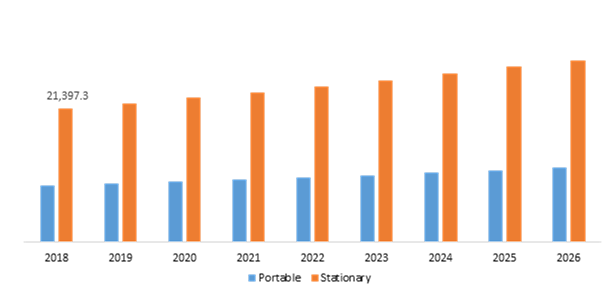
Source: Research Dive Analysis
Portable air compressors market generated a revenue of $9,119.9 million in 2018, and is further projected to reach up to $11,916.6 million by the year of 2026. The segmentation of market by product consists of portable and Stationary. Oil & gas exploration activities, Construction and mining industries have usage of portable machineries as the sites are constantly getting moved. These industries will help the air compressor market grow in the forecasted period.
The stationery machineries are extensively used in the industries like manufacturing, home appliances, and automobile, which will increase the demand of the stationery air compressors in the forecasted period.
Air Compressor Market, by Technology:
Rotary Compressor segment is will generate revenue of $17,575.1 million by the year of 2026
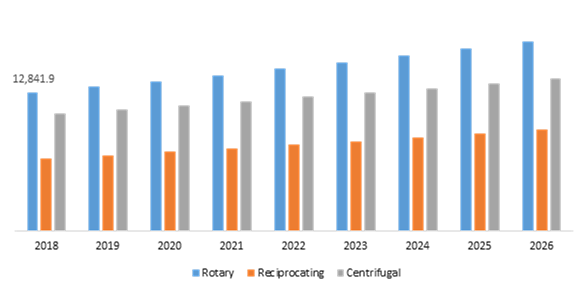
Source: Research Dive Analysis
Rotary compressor market registered revenue of $12,841.9 million in 2018, and is further anticipated to generate revenue up to $17,575.1 by the year of 2026.By Technology, the segmentation is as follows: Rotary, Reciprocating and Centrifugal. Rotary type air compressors are majorly used in heavy industrial and manufacturing applications, whereas the reciprocating type are used in oil & gas industry. But rotary compressors will take over the market share of the reciprocating compressors in the near future, reason being the superiority to reciprocating compressors in department of efficiency, power and reduced noise.
Air Compressor Market, by Lubrication:
Oil Free Air Compressor segment will possess high investment opportunities in the coming future
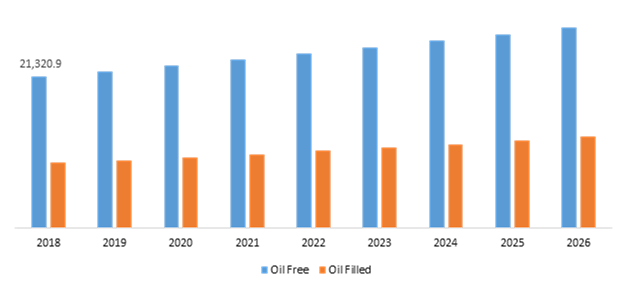
Source: Research Dive Analysis
Oil free air compressor market generated revenue of $21,320.9 million in 2018, and is further predicted to reach up to $28,293.3 million by the year of 2026. By Lubrication, the segment is divided into Oil Free and Oil Filled. Heavy work activities like oil extraction, drilling, and mining drive the oil filled air compressor market demand. Rising oil extraction activities in the Middle East, North America and Asia Pacific will drive the industry in the forecasted period.
Oil free compressors are used in Food & beverages industries so as to avoid the contamination of the product by oil. Thus F&B and healthcare will increase the demand of oil free air compressors in the forecasted period.
Air Compressor Market, by Application:
Health Care Industries & Home Appliances segment is predicted to be most lucrative till the end of 2026
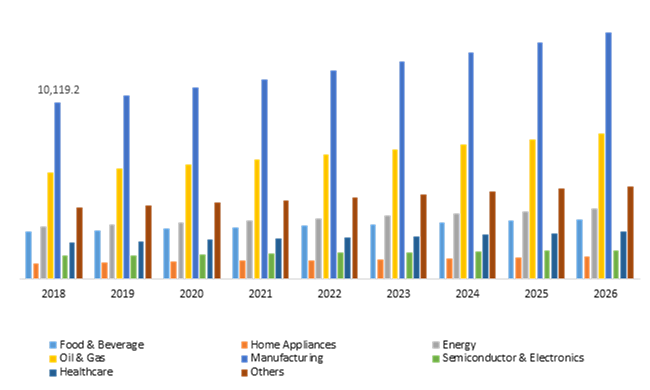
Source: Research Dive Analysis
Home appliances segment generated revenue of $922.6 million in 2018, and is further estimated to reach upto $1,322.1 million by the year of 2026.
By Application, the segmentation is done into Home Appliances, Food & Beverage, Oil & Gas, Manufacturing and Healthcare. F&B sector has witnessed a tremendous growth in previous years and is expected to maintain this momentum during the forecast years. Policy liberalization in F&B and electronics industries in region like Asia-Pacific, particularly in India, has enhanced the need for energy efficient air compressors.
Home appliances & health care industries will also boost the market of oil free air compressors during the forecasted period; this will be due to the high efficiency, low noise and higher accuracy of the newer compressors.
Regional Growth of Air Compressor Market:
Asia-Pacific region will have enormous opportunities for the market investors to grow over the coming years
Asia-Pacific’s air compressor market size shall generate revenue of $16,127.4 million till 2026. Asia Pacific air compressor market is expected to show high growth on account of growing manufacturing facilities and infrastructure spending in developing countries like India and China. Middle East & Africa and Latin America are expected to witness significant growth over the forecasted period owing to Increasing availability of labors & raw materials, changing regulatory scenario and growing awareness towards eco-friendly products. North America and Europe air compressor markets are anticipated to grow at a seemingly low rate owing to end-use industry saturation.
Key participants in Global Air Compressor Market:
Product development and joint ventures are the most common strategies followed by the market players
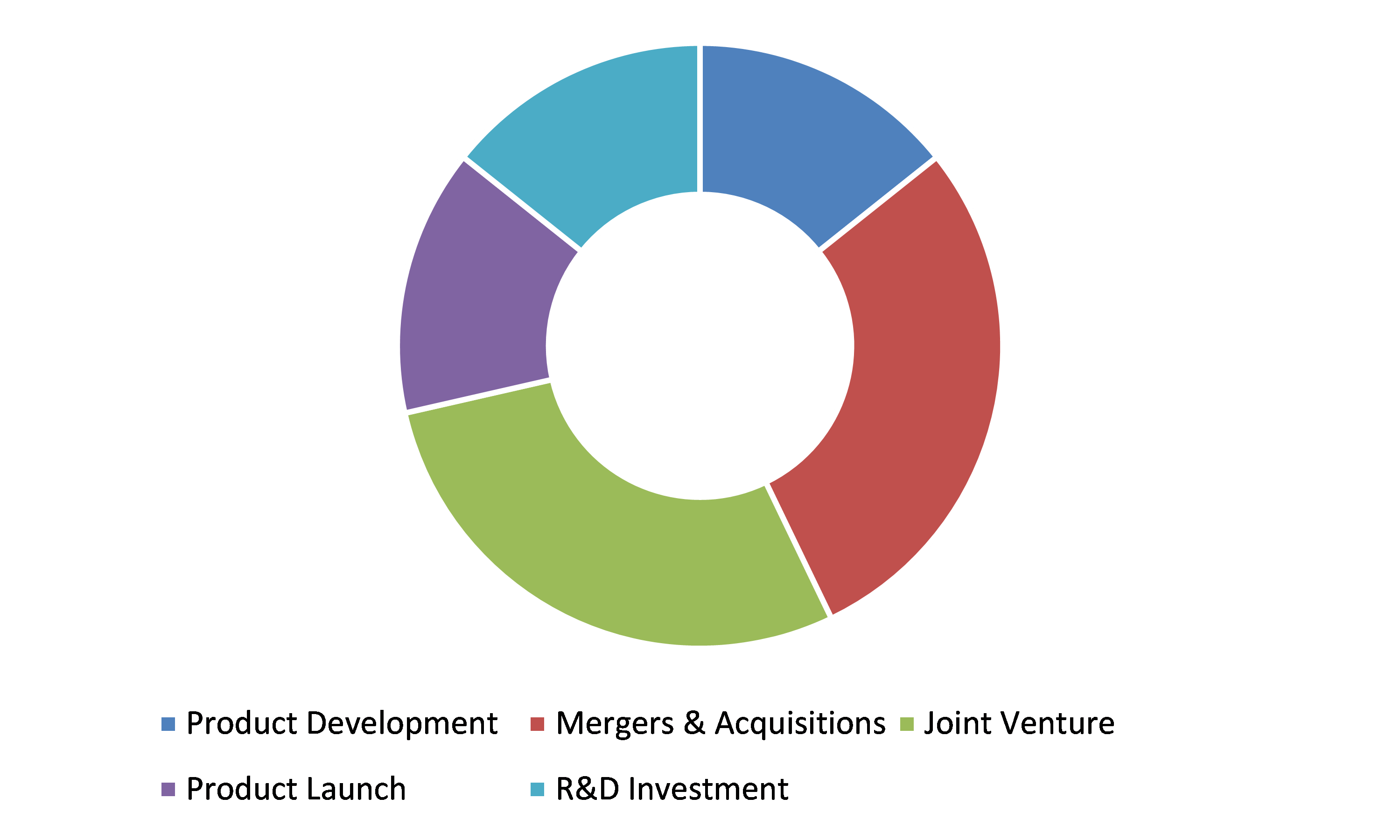
Source: Research Dive Analysis
Some of the air compressors market players are Atlas Copco, Oasis Manufacturing, Elgi Equipments, Ingersoll-Rand, Siemens, Kobe Steel, Frank Technologies, Grainger Company, Bel Aire Compressors, Bauer Group, VMAC Company, Airtex Compressors, Ingersoll Rand, Sullair, and Best Aire LLC are among many others. Increasing use of better quality and technologically updated products in appliances, medical instruments and other industrial machineries will propel the air compressor market share in coming years.
Scope of the Market Report:
| Aspect | Particulars |
| Historical Market Estimations | 2016-2018 |
| Base Year for Market Estimation | 2018 |
| Forecast timeline for Market Projection | 2019-2026 |
| Geographical Scope | North America, Europe, Asia-Pacific, LAMEA |
| Segmentation By Product |
|
| Segmentation By Technology |
|
| Segmentation By Lubrication |
|
| Segmentation By Application |
|
| Key Countries covered | U.S., Canada, Germany, France, UK, Spain, Russia, China, Japan, India, South Korea, Malaysia, Mexico, Argentina, Brazil, Colombia, Saudi Arabia, UAE, South Africa |
| Top Key Companies in Air Compressor Market: |
|
Q1. What is the size of Air Compressors Market?
A. The global Air Compressors Market size was over $30,517.2 million in 2018, and is further anticipated to reach $41126.7 million by 2026.
Q2. Who are the leading companies in the Air Compressor Market?
A. Siemens, Sullair and Airtex Compressors are some of the significant players in the air compressor market.
Q3. Which region possess greater investment opportunities in the coming future for Air Compressor Market?
A. Asia-Pacific region possess great investment opportunities for the investors to witness the most promising growth in the coming years.
Q4. What is the growth rate of the Asia-Pacific Air Compressor Market?
A. Asia-Pacific air compressors market is projected to grow at 3.5% CAGR during the forecast period.
Q5. What are the strategies opted by the leading players in the Air Compressor Market?
A. Product development, and joint ventures are the key strategies opted by the operating companies in this market.
Q6. Which companies are investing more on R&D practices for Air Compressor Market?
A. Kobe Steels and Siemens companies are investing more on R&D activities for developing new products and technologies.
1. Research Methodology
1.1. Desk Research
1.2. Real time insights and validation
1.3. Forecast model
1.4. Assumptions and forecast parameters
1.4.1. Assumptions
1.4.2. Forecast parameters
1.5. Data sources
1.5.1. Primary
1.5.2. Secondary
2. Executive Summary
2.1. 360° summary
2.2. Product
2.3. Technology
2.4. Lubrication
2.5. Application
3. Market overview
3.1. Market segmentation & definitions
3.2. Key takeaways
3.2.1. Top investment pockets
3.2.2. Top winning strategies
3.3. Porter’s five forces analysis
3.3.1. Bargaining power of consumers
3.3.2. Bargaining power of suppliers
3.3.3. Threat of new entrants
3.3.4. Threat of substitutes
3.3.5. Competitive rivalry in the market
3.4. Market dynamics
3.4.1. Drivers
3.4.2. Restraints
3.4.3. Opportunities
3.5. Technology landscape
3.6. Regulatory landscape
3.7. Patent landscape
3.8. Market value chain analysis
3.8.1. Stress point analysis
3.9. Strategic overview
4. Air Compressor Market, by Product
4.1. Portable
4.1.1. Market size and forecast, by region, 2016-2026
4.1.2. Comparative market share analysis, 2018 & 2026
4.2. Stationary
4.2.1. Market size and forecast, by region, 2016-2026
4.2.2. Comparative market share analysis, 2018 & 2026
5. Air Compressor Market, by Technology
5.1. Rotary
5.1.1. Market size and forecast, by region, 2016-2026
5.1.2. Comparative market share analysis, 2018 & 2026
5.2. Reciprocating
5.2.1. Market size and forecast, by region, 2016-2026
5.2.2. Comparative market share analysis, 2018 & 2026
5.3. Centrifugal
5.3.1. Market size and forecast, by region, 2016-2026
5.3.2. Comparative market share analysis, 2018 & 2026
6. Air Compressor Market, by Lubrication
6.1. Oil Free
6.1.1. Market size and forecast, by region, 2016-2026
6.1.2. Comparative market share analysis, 2018 & 2026
6.2. Oil Filled
6.2.1. Market size and forecast, by region, 2016-2026
6.2.2. Comparative market share analysis, 2018 & 2026
7. Air Compressor Market, by Application
7.1. Home Appliances
7.1.1. Market size and forecast, by region, 2016-2026
7.1.2. Comparative market share analysis, 2018 & 2026
7.2. Food & Beverage
7.2.1. Market size and forecast, by region, 2016-2026
7.2.2. Comparative market share analysis, 2018 & 2026
7.3. Oil & Gas
7.3.1. Market size and forecast, by region, 2016-2026
7.3.2. Comparative market share analysis, 2018 & 2026
7.4. Manufacturing
7.4.1. Market size and forecast, by region, 2016-2026
7.4.2. Comparative market share analysis, 2018 & 2026
7.5. Healthcare
7.5.1. Market size and forecast, by region, 2016-2026
7.5.2. Comparative market share analysis, 2018 & 2026
8. Air Compressor Market, by Region
8.1. North America
8.1.1. Market size and forecast, by product, 2016-2026
8.1.2. Market size and forecast, by technology, 2016-2026
8.1.3. Market size and forecast, by lubrication, 2016-2026
8.1.4. Market size and forecast, by application, 2016-2026
8.1.5. Market size and forecast, by country, 2016-2026
8.1.6. Comparative market share analysis, 2018 & 2026
8.1.7. U.S.
8.1.7.1. Market size and forecast, by product, 2016-2026
8.1.7.2. Market size and forecast, by technology, 2016-2026
8.1.7.3. Market size and forecast, by lubrication, 2016-2026
8.1.7.4. Market size and forecast, by application, 2016-2026
8.1.7.5. Comparative market share analysis, 2018 & 2026
8.1.8. Canada
8.1.8.1. Market size and forecast, by product, 2016-2026
8.1.8.2. Market size and forecast, by technology, 2016-2026
8.1.8.3. Market size and forecast, by lubrication, 2016-2026
8.1.8.4. Market size and forecast, by application, 2016-2026
8.1.8.5. Comparative market share analysis, 2018 & 2026
8.1.9. Mexico
8.1.9.1. Market size and forecast, by product, 2016-2026
8.1.9.2. Market size and forecast, by technology, 2016-2026
8.1.9.3. Market size and forecast, by lubrication, 2016-2026
8.1.9.4. Market size and forecast, by application, 2016-2026
8.1.9.5. Comparative market share analysis, 2018 & 2026
8.2. Europe
8.2.1. Market size and forecast, by product, 2016-2026
8.2.2. Market size and forecast, by technology, 2016-2026
8.2.3. Market size and forecast, by lubrication, 2016-2026
8.2.4. Market size and forecast, by application, 2016-2026
8.2.5. Market size and forecast, by country, 2016-2026
8.2.6. Comparative market share analysis, 2018 & 2026
8.2.7. Germany
8.2.7.1. Market size and forecast, by product, 2016-2026
8.2.7.2. Market size and forecast, by technology, 2016-2026
8.2.7.3. Market size and forecast, by lubrication, 2016-2026
8.2.7.4. Market size and forecast, by application, 2016-2026
8.2.7.5. Comparative market share analysis, 2018 & 2026
8.2.8. Spain
8.2.8.1. Market size and forecast, by product, 2016-2026
8.2.8.2. Market size and forecast, by technology, 2016-2026
8.2.8.3. Market size and forecast, by lubrication, 2016-2026
8.2.8.4. Market size and forecast, by application, 2016-2026
8.2.8.5. Comparative market share analysis, 2018 & 2026
8.2.9. France
8.2.9.1. Market size and forecast, by product, 2016-2026
8.2.9.2. Market size and forecast, by technology, 2016-2026
8.2.9.3. Market size and forecast, by lubrication, 2016-2026
8.2.9.4. Market size and forecast, by application, 2016-2026
8.2.9.5. Comparative market share analysis, 2018 & 2026
8.2.10. Italy
8.2.10.1. Market size and forecast, by product, 2016-2026
8.2.10.2. Market size and forecast, by technology, 2016-2026
8.2.10.3. Market size and forecast, by lubrication, 2016-2026
8.2.10.4. Market size and forecast, by application, 2016-2026
8.2.10.5. Comparative market share analysis, 2018 & 2026
8.2.11. Rest of the Europe
8.2.11.1. Market size and forecast, by product, 2016-2026
8.2.11.2. Market size and forecast, by technology, 2016-2026
8.2.11.3. Market size and forecast, by lubrication, 2016-2026
8.2.11.4. Market size and forecast, by application, 2016-2026
8.2.11.5. Comparative market share analysis, 2018 & 2026
8.3. Asia-Pacific
8.3.1. Market size and forecast, by product, 2016-2026
8.3.2. Market size and forecast, by technology, 2016-2026
8.3.3. Market size and forecast, by lubrication, 2016-2026
8.3.4. Market size and forecast, by application, 2016-2026
8.3.5. Market size and forecast, by country, 2016-2026
8.3.6. Comparative market share analysis, 2018 & 2026
8.3.7. China
8.3.7.1. Market size and forecast, by product, 2016-2026
8.3.7.2. Market size and forecast, by technology, 2016-2026
8.3.7.3. Market size and forecast, by lubrication, 2016-2026
8.3.7.4. Market size and forecast, by application, 2016-2026
8.3.7.5. Comparative market share analysis, 2018 & 2026
8.3.8. Japan
8.3.8.1. Market size and forecast, by product, 2016-2026
8.3.8.2. Market size and forecast, by technology, 2016-2026
8.3.8.3. Market size and forecast, by lubrication, 2016-2026
8.3.8.4. Market size and forecast, by application, 2016-2026
8.3.8.5. Comparative market share analysis, 2018 & 2026
8.3.9. India
8.3.9.1. Market size and forecast, by product, 2016-2026
8.3.9.2. Market size and forecast, by technology, 2016-2026
8.3.9.3. Market size and forecast, by lubrication, 2016-2026
8.3.9.4. Market size and forecast, by application, 2016-2026
8.3.9.5. Comparative market share analysis, 2018 & 2026
8.3.10. Australia
8.3.10.1. Market size and forecast, by product, 2016-2026
8.3.10.2. Market size and forecast, by technology, 2016-2026
8.3.10.3. Market size and forecast, by lubrication, 2016-2026
8.3.10.4. Market size and forecast, by application, 2016-2026
8.3.10.5. Comparative market share analysis, 2018 & 2026
8.3.11. South Korea
8.3.11.1. Market size and forecast, by product, 2016-2026
8.3.11.2. Market size and forecast, by technology, 2016-2026
8.3.11.3. Market size and forecast, by lubrication, 2016-2026
8.3.11.4. Market size and forecast, by application, 2016-2026
8.3.11.5. Comparative market share analysis, 2018 & 2026
8.3.12. Rest of the Asia Pacific
8.3.12.1. Market size and forecast, by product, 2016-2026
8.3.12.2. Market size and forecast, by technology, 2016-2026
8.3.12.3. Market size and forecast, by lubrication, 2016-2026
8.3.12.4. Market size and forecast, by application, 2016-2026
8.3.12.5. Comparative market share analysis, 2018 & 2026
8.4. LAMEA
8.4.1. Market size and forecast, by product, 2016-2026
8.4.2. Market size and forecast, by technology, 2016-2026
8.4.3. Market size and forecast, by lubrication, 2016-2026
8.4.4. Market size and forecast, by application, 2016-2026
8.4.5. Market size and forecast, by country, 2016-2026
8.4.6. Comparative market share analysis, 2018 & 2026
8.4.7. Brazil
8.4.7.1. Market size and forecast, by product, 2016-2026
8.4.7.2. Market size and forecast, by technology, 2016-2026
8.4.7.3. Market size and forecast, by lubrication, 2016-2026
8.4.7.4. Market size and forecast, by application, 2016-2026
8.4.7.5. Comparative market share analysis, 2018 & 2026
8.4.8. Saudi Arabia
8.4.8.1. Market size and forecast, by product, 2016-2026
8.4.8.2. Market size and forecast, by technology, 2016-2026
8.4.8.3. Market size and forecast, by lubrication, 2016-2026
8.4.8.4. Market size and forecast, by application, 2016-2026
8.4.8.5. Comparative market share analysis, 2018 & 2026
8.4.9. South Africa
8.4.9.1. Market size and forecast, by product, 2016-2026
8.4.9.2. Market size and forecast, by technology, 2016-2026
8.4.9.3. Market size and forecast, by lubrication, 2016-2026
8.4.9.4. Market size and forecast, by application, 2016-2026
8.4.9.5. Comparative market share analysis, 2018 & 2026
8.4.10. Rest of LAMEA
8.4.10.1. Market size and forecast, by product, 2016-2026
8.4.10.2. Market size and forecast, by technology, 2016-2026
8.4.10.3. Market size and forecast, by lubrication, 2016-2026
8.4.10.4. Market size and forecast, by application, 2016-2026
8.4.10.5. Comparative market share analysis, 2018 & 2026
9. Company profiles
9.1. Atlas Copco
9.1.1. Business overview
9.1.2. Financial performance
9.1.3. Product portfolio
9.1.4. Recent strategic moves & developments
9.1.5. SWOT analysis
9.2. Oasis Manufacturing
9.2.1. Business overview
9.2.2. Financial performance
9.2.3. Product portfolio
9.2.4. Recent strategic moves & developments
9.2.5. SWOT analysis
9.3. Elgi Equipments
9.3.1. Business overview
9.3.2. Financial performance
9.3.3. Product portfolio
9.3.4. Recent strategic moves & developments
9.3.5. SWOT analysis
9.4. Ingersoll-Rand
9.4.1. Business overview
9.4.2. Financial performance
9.4.3. Product portfolio
9.4.4. Recent strategic moves & developments
9.4.5. SWOT analysis
9.5. Siemens
9.5.1. Business overview
9.5.2. Financial performance
9.5.3. Product portfolio
9.5.4. Recent strategic moves & developments
9.5.5. SWOT analysis
9.6. Kobe steel
9.6.1. Business overview
9.6.2. Financial performance
9.6.3. Product portfolio
9.6.4. Recent strategic moves & developments
9.6.5. SWOT analysis
9.7. Frank technologies
9.7.1. Business overview
9.7.2. Financial performance
9.7.3. Product portfolio
9.7.4. Recent strategic moves & developments
9.7.5. SWOT analysis
9.8. Grainger company
9.8.1. Business overview
9.8.2. Financial performance
9.8.3. Product portfolio
9.8.4. Recent strategic moves & developments
9.8.5. SWOT analysis
9.9. Bel Aire Compressors
9.9.1. Business overview
9.9.2. Financial performance
9.9.3. Product portfolio
9.9.4. Recent strategic moves & developments
9.9.5. SWOT analysis
9.10. Bauer Group
9.10.1. Business overview
9.10.2. Financial performance
9.10.3. Product portfolio
9.10.4. Recent strategic moves & developments
9.10.5. SWOT analysis
Air compressors are rightly called as the backbone of the industrial world. This is because they are used in several application areas for a wide range of uses. For several decades, the industrial sector has shown major trust and has been highly dependent upon the energy-efficient, safe, and high-output capabilities of air compressors.
Growing demand for air compressors
Air compressor is a mechanical device that compresses and pressurizes air to convert into usable power for various applications. Nowadays, the rising popularity and demand for air compressors from various application sectors is leading to the growth and development of the air compressor market. This is mainly because of the various benefits offered by air compressors such as easy maintenance, low cost, and reliability. Apart from these benefits, many manufacturing companies are opting for this device due its features such as oil-free lubrication processes and portability of energy efficient models.
Additionally, air compressors are widely used in the oil and gas sector for several purposes. As the demand for F&B and oil & petroleum is growing every other day, the demand for high powered and highly efficient air compressors is also growing. However, strict rules and regulations by government about the level of noise and greenhouse gases emitted by the air compressors are acting like a major barrier for air compressor manufacturers—which is surely going to affect the growth of the global air compressor industry.
Growing developments in the market
Today, technology is advancing at an ever-increasing speed not only by considering the human requirements but also by keeping in mind nature’s safety. Several manufacturers in the air compressor industry are now concentrating on developing environment friendly compressor technologies.
In 2019, Gardner Denver Holdings Inc., an American worldwide provider of industrial machineries, technologies, and related parts and services had entered into a deal to merge with Ingersoll-Rand Plc. Both the companies are into manufacturing of pumps and compressors. This deal has given birth to the world's second-largest manufacturer of industrial pumps and compressor.
Apart from these companies there are various other manufacturers functioning in the air compressor market. Some of these are Atlas Copco, Ingersoll-Rand, Elgi Equipments, Siemens, Kobe Steel, Oasis Manufacturing, Frank Technologies, Grainger Company, Bauer Group, Bel Aire Compressors, VMAC Company, Airtex Compressors, Sullair, Best Aire LLC, and many more. According to a report by Research Dive, the growth in use of quality and technologically advanced components in equipment, medical devices, and other industrial machines are seen as a major booster to the growth of the air compressor market in the next few years. Also, those companies that are using advanced technologies for their compressors are expected to have an upper hand in the industry.
Future scope of the air compressor industry
As air compressors are considered as a much safer option as compared to other equipment, they are gaining popularity in several parts of the world. Currently, Asia Pacific region is showing tremendous growth in the air compressor industry due to the advancements in manufacturing services and increase in investment for infrastructure in emerging countries such as India and China. These countries have strong oil & gas infrastructure and are expected to have most rewarding opportunities for the air compressors market. Hence, the Asia-Pacific region is expected to dominate the market, owing to the rapid industrialization of these countries.
On the other hand, the industry is expected to foresee a significant growth in Middle East & Africa and Latin America due to rise in availability of labors & raw materials, changing regulatory scenario, and growing awareness about eco-friendly products. Considering the geographical growth and growing application areas of the market it can be stated that the global air compressor industry is walking its way toward success.
Personalize this research
- Triangulate with your own data
- Request your format and definition
- Get a deeper dive on a specific application, geography, customer or competitor
- + 1-888-961-4454 Toll - Free
- support@researchdive.com

